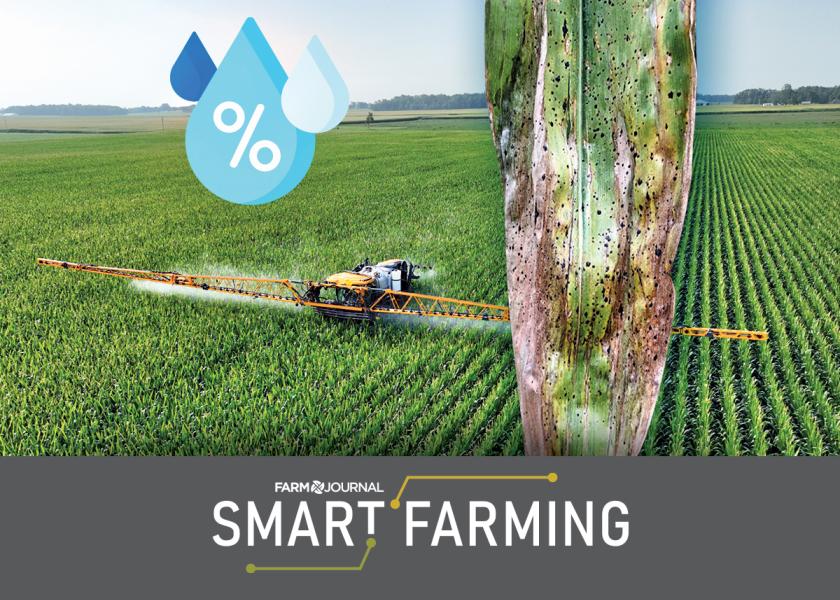You Can't Afford to Be Complacent About Tar Spot

Farm Journal’s Smart Farming Week is an annual week-long emphasis on innovation in agriculture. The goal is to encourage you to explore and prioritize the technology, tools and practices that will help you farm smarter. Innovation today ensures an efficient, productive and sustainable tomorrow.
The yield-crippling devastation tar spot caused to corn crops across southern Michigan in 2021 still weighs on Missy Bauer today, three years later.
She worries farmers have grown complacent toward the disease, as it was mostly a no-show in 2022 and 2023. She contends that fact doesn’t mean 2024 will be clear sailing for corn growers.
“I don’t think we have any less of a threat because the inoculum is widespread in fields across the Corn Belt. It hasn’t gone away,” says Bauer, Farm Journal field agronomist and owner of B&M Crop Consulting in Coldwater, Mich.
The Crop Protection Network estimates U.S. corn growers lost around $3 billion to tar spot from 2018 through 2022. Of that amount, $1.25 billion was lost in 2021 alone.
Environmental Factors Play A Role
Bauer believes most corn growers got a reprieve from tar spot in 2021 and 2022 because the disease triangle never fully materialized. For crippling levels of tar spot to strike, all three sides of the disease triangle must be in place: a susceptible host, virulent pathogen and favorable environment.
It’s the third factor, specifically humidity levels, Bauer says is like a canary in the coal mine for tar spot. A humidity level of 75% or higher over multiple consecutive days during the growing season can be an early indication tar spot might strike.
“If you’re above a daily average of 75%, your risk for the environment being right for tar spot to develop into a full-blown problem is much greater,” Bauer says.

Tell-Tale Signs
Looking back, she sees how that was true in 2021. That year, she started tracking humidity levels on June 20 and continued through July 31. Of those 41 days, 35 of them reached daily average humidity levels of 75% or higher.
By late summer, tar spot struck many southern Michigan corn crops with a vengeance.
“It was horrible, a firestorm,” Bauer recalls. “Some fields had 50-bu.-plus per acre yield losses.”
During the next two years, she saw the opposite occur. In 2022, during the same 41-day period, only seven days saw daily average humidity levels reach 75% or higher. In 2023, only 13 days reached or exceeded that percentage.
“If you’re above a daily average of 75%, your risk for the environment being right for tar spot to develop into a full-blown problem is much greater,” Missy Bauer says.
How To Use The Data
Today, Bauer starts tracking humidity levels on or about June 1 and uses the commercial service Weather Underground for that purpose. It provides historical weather-specific information for growers who need the historical data to reference.
The value of tracking humidity levels over time is it can help growers be more successful in predicting whether tar spot will be an issue, Bauer says. It also can help growers determine when to apply a foliar fungicide.
“For the most part, we’re going to apply a fungicide sometime between R1 through R3. But whether I go with F1, right at silking or I push it back a little bit and go a little closer to milk stage depends on what’s happened with the humidity levels I’ve been charting,” she says.
“Looking back at the 2021 data, we should have been spraying right around silking, or at the latest R2, and then planned a second fungicide pass,” she says. “If that kind of data pops up this next season that’s what my recommendation would likely be.”
However, if the 2024 data is more aligned with what occurred in 2022 and 2023, Bauer would consider making an initial fungicide application a bit later than R2 with the goal of giving corn better late-season protection from tar spot.
“Tracking the data helps me dial-in the application timing for my first fungicide pass and then whether I should plan on making a second application,” she says.

Plan On One Application
Bauer’s test plot research the past few years has shown corn is gaining enough plant health benefits that at least one in-season fungicide application will pay for itself, regardless of whether tar spot is a concern.
In addition, she is encouraging farmers to make the investment in higher end fungicide products.
“If they’re going to put on a fungicide, I’d go with the newer chemistries, the ones offering three modes of action. These products are more expensive, but our data shows they’re worth the cost; the ROI has been there,” she says.
As growers complete their hybrid lineup for 2024, Bauer says they need to ask their seed reps for hybrids that offer both good yield potential and a high rating for tar spot.
“You have to respect both, and from what we’ve seen in our data, there can be a huge difference in tolerance among hybrids,” she says.
Following that advice, along with tracking what Mother Nature throws their way, can help growers chart their way to corn-growing success in the coming season.
More Smart Farming content for you:
10 Easy Ways to Take Your Crop-Scouting Practices to the Next Level







